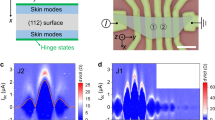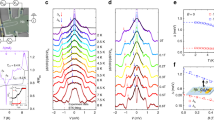Abstract
In topological materials, the edge states are readily distinguished from the bulk states. The situation where a topological semimetal becomes superconducting so that Cooper pairs occupy both the bulk and the edge states is not well understood. In particular, we do not know if we can force their pairing symmetries to be different. Here we show that, when supercurrent is injected into the superconducting Weyl semimetal MoTe2 from Nb contacts, the invasive s-wave pairing potential from Nb is incompatible with the intrinsic Cooper pair condensate in MoTe2. This incompatibility leads to strong stochasticity in the switching current and an unusual anti-hysteretic behaviour in the current–voltage loops. There is also an asymmetry in the edge oscillations where, as the magnetic field crosses zero, the phase noise switches from one with a noisy spectrum to one that is noise free. Using the noise spectrum as a guide, we track the anomalous features to field-induced switching of the device gap function between s-wave symmetry and the unconventional symmetry intrinsic to MoTe2. We infer that the behaviour of the gap function along the edges is different from that in the bulk.
This is a preview of subscription content, access via your institution
Access options
Access Nature and 54 other Nature Portfolio journals
Get Nature+, our best-value online-access subscription
$29.99 / 30 days
cancel any time
Subscribe to this journal
Receive 12 print issues and online access
$209.00 per year
only $17.42 per issue
Buy this article
- Purchase on Springer Link
- Instant access to full article PDF
Prices may be subject to local taxes which are calculated during checkout






Similar content being viewed by others
Data availability
The data presented in this work are available in a figshare repository18. Source data are provided with the paper. Any additional data are available from the corresponding author upon request.
References
Fu, L. & Kane, C. L. Superconducting proximity effect and Majorana fermions at the surface of a topological insulator. Phys. Rev. Lett. 100, 096407 (2008).
Qi, X.-L., Hughes, T. L., Raghu, S. & Zhang, S.-C. Time reversal invariant topological superconductors and superfluids in two and three dimensions. Phys. Rev. Lett. 102, 187001 (2009).
Fu, L. & Berg, E. Odd-parity topological superconductors: theory and application to CuxBi2Se3. Phys. Rev. Lett. 105, 097001 (2010).
Peng, Y., Pientka, F., Berg, E., Oreg, Y. & von Oppen, F. Signatures of topological Josephson junctions. Phys. Rev. B 94, 085409 (2016).
Wang, W. et al. Evidence for an edge supercurrent in the Weyl superconductor MoTe2. Science 368, 534–537 (2020).
de Gennes, P. G. Boundary effects in superconductors. Rev. Mod. Phys. 36, 225–237 (1964).
de Gennes, P. G. Superconductivity of Metals and Alloys (Addison Wesley, 1989).
Deutscher, G. & de Gennes, P. G. Proximity effects. In Superconductivity, Vol. II (ed. Parks, R. D.) (Taylor and Francis, 1969).
Ashauer, B., Kieselmann, G. & Rainer, D. On the proximity effect in unconventional superconductors. J. Low Temp. Phys. 63, 349–366 (1986).
Millis, A., Rainer, D. & Sauls, J. A. Quasiclassical theory of superconductivity near magnetically active interfaces. Phys. Rev. B 38, 4504 (1988).
Sigrist, M. & Ueda, K. Phenomenological theory of unconventional superconductivity. Rev. Mod. Phys. 63, 239–311 (1991).
Murani, A. et al. Ballistic edge states in Bismuth nanowires revealed by SQUID interferometry. Nat. Commun. 8, 15941 (2017).
Wang, Y. et al. Anisotropic proximity–induced superconductivity and edge supercurrent in Kagome metal, K1−xV3Sb5. Sci. Adv. 9, eadg726 (2023).
Safar, H. et al. Experimental evidence for a multicritical point in the magnetic phase diagram for the mixed state of clean, untwinned YBa2Cu3O7. Phys. Rev. Lett. 70, 3800 (1993).
Zeldov, E. et al. Thermodynamic observation of first-order vortex-lattice melting transition in Bi2Sr2CaCu208. Nature 375, 373–376 (1995).
Welp, U., Fendrich, J. A., Kwok, W. K., Crabtree, G. W. & Veal, B. W. Thermodynamic evidence for a flux line lattice melting transition in YBa2Cu3O7−δ. Phys. Rev. Lett. 76, 4809 (1996).
Soibel, A. et al. Imaging the vortex-lattice melting process in the presence of disorder. Nature 406, 282–287 (2000).
Kim, S., Lei, S., Schoop, L. M., Cava, R. J. & Ong, N. P. Edge supercurrent reveals competition between condensates in a Weyl superconductor. Data sets. figshare https://doi.org/10.6084/m9.figshare.22635019 (2023).
Acknowledgements
We benefitted from discussions with W. Wang and Z. Zhu. N.P.O. and S.K. were supported by the United States Department of Energy (DE-SC0017863). The crystal growth effort was supported by an MRSEC grant from the United States National Science Foundation (NSF DMR-2011750) that supported S.L., L.M.S., R.J.C. and N.P.O. The Gordon and Betty Moore Foundation’s EPiQS initiative provided generous support via grants GBMF9466 (N.P.O.) and GBMF9064 (L.M.S.).
Author information
Authors and Affiliations
Contributions
S.K. and N.P.O. conceptualized and designed the experiment. S.K. performed all device fabrication and measurements. The crystals were grown by S.L., L.M.S. and R.J.C. Analysis of the data was carried out by S.K. and N.P.O., who jointly wrote the manuscript.
Corresponding author
Ethics declarations
Competing interests
The authors declare no competing interests.
Peer review
Peer review information
Nature Physics thanks Guangtong Liu and the other, anonymous, reviewer(s) for their contribution to the peer review of this work.
Additional information
Publisher’s note Springer Nature remains neutral with regard to jurisdictional claims in published maps and institutional affiliations.
Supplementary information
Supplementary Information
Supplementary Figs. 1–11, Table S1, additional analyses, data and discussion.
Source data
Source Data Fig. 1
Data for Fig. 1a–e.
Source Data Fig. 2
Data for Fig. 2a–d.
Source Data Fig. 3
Data for Fig. 3a–d.
Source Data Fig. 4
Data for Fig. 4e–l.
Source Data Fig. 5
Data for Fig. 5a–c.
Source Data Fig. 6
Data for Fig. 6c–g.
Rights and permissions
Springer Nature or its licensor (e.g. a society or other partner) holds exclusive rights to this article under a publishing agreement with the author(s) or other rightsholder(s); author self-archiving of the accepted manuscript version of this article is solely governed by the terms of such publishing agreement and applicable law.
About this article
Cite this article
Kim, S., Lei, S., Schoop, L.M. et al. Edge supercurrent reveals competition between condensates in a Weyl superconductor. Nat. Phys. 20, 261–268 (2024). https://doi.org/10.1038/s41567-023-02316-9
Received:
Accepted:
Published:
Issue Date:
DOI: https://doi.org/10.1038/s41567-023-02316-9



